A great-sounding set of speakers can make all the difference in creating the audio setup of your dreams, with different brands, models, shapes, and sizes bringing their own unique sound signatures to your music.
And whether that source is your smartphone's Spotify app, a sweet-sounding stereo receiver or integrated amplifier, a turntable, or an elaborate AV receiver that's delivering Dolby Atmos surround sound throughout your home theater, the speakers you choose are going to make a big difference in how good everything sounds.
But it's an audio jungle out there, and choosing speakers can be a challenge. What do you need? Big tower speakers or a set of surrounds and a subwoofer to fill a large room? Or will compact bookshelf speakers or even a Bluetooth speaker do the trick to make your music sound clear and full?
Modern speakers offer up a bigger range of connectivity options than ever, including wireless (Wi-Fi and Bluetooth), HDMI, digital optical, USB, and old-school analog RCA. And while it's nice to have all this choice, sometimes a helping hand is necessary to steer you in the right direction, which is why we've compiled this list of some of the best speakers out there.









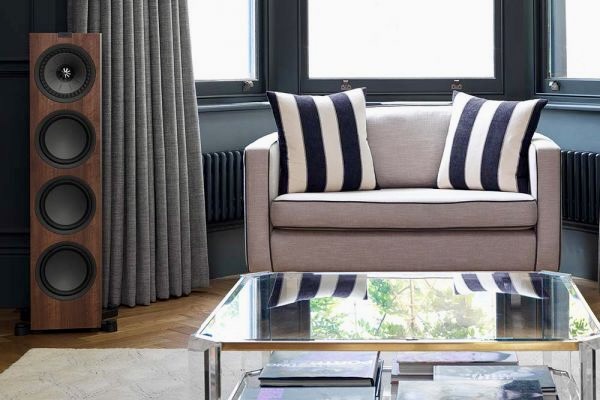
The best floorstanding speakers
KEF Q750
- Uni-Q tech delivers robust three-dimensional sound
- Articulate, near-distortion-free sound profile
- Astonishing price-to-performance ratio
- Sleek and stylish design
- Not ideal for smaller rooms
- High frequencies may be too bright for some
When it comes to a perfect set of speakers for the modern age of listening, KEF is a powerful name that comes up again and again. Earning laurels left and right, the idea behind a set of KEF cabinets and drivers is ultra-stylized, high-performance equipment that kicks down the doors of every music and film genre they're tasked with tackling.
This leads us to the KEF Q750: the tower speakers built for all of your listening needs. Available in black, white, and walnut finishes (with magnetized grilles sold separately), the Q750 is engineered from the ground up to dig out the details in your hi-fi system that other speakers simply can't touch.
Featuring the amazing Uni-Q driver array that seats the tweeter in the center of the midrange cone, KEF's idea for this placement choice is to unify the acoustics in a way that maximizes three-dimensional sound-staging like never before. While this bit of phrasing gets thrown around in the audio space all too often, let's just say the Q750 will truly make you feel like you're at a live concert or seated in a movie theater.
On top of an enhanced woofer design that adds additional layering to both the midrange and low-end spectrums, the KEF Q750 are built for the kind of stellar sonic experience that you'd normally be paying another $1,000 (or more) for.
While a pair is still going to run you close to $2,000 (its younger sibling, the Q550, runs $1,500/pair and its big brother, the Q950, goes for $1,600/pair) it'll be the best money you've ever spent on audio.

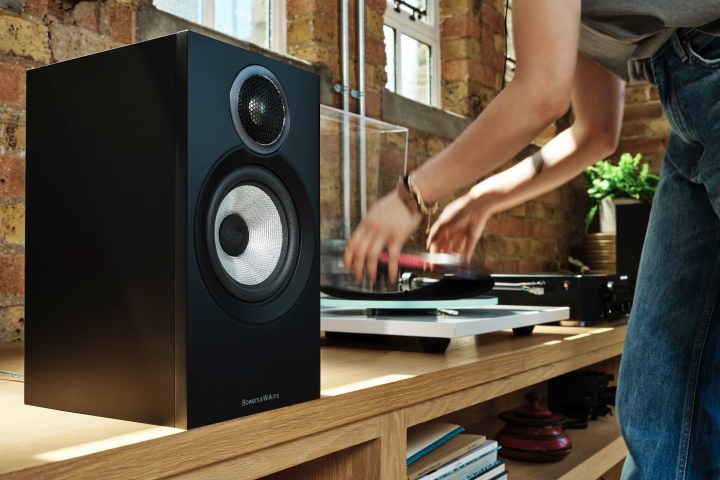
Best passive bookshelf/standmount speakers
Bowers & Wilkins 607 S3
- Near unrivaled clarity and precision
- Clean, tight mids and lows
- Big bass for their size
- Good, but not cheap
From analog-loving vinyl nerds to even the most discerning of digital defenders, audiophiles across the spectrum can agree Bowers & Wilkins is synonymous with great-sounding speakers.
B&W's 606 and 607 S2 Anniversary range of bookshelf speakers, the former of which previously held a spot on this list, sold like hot cakes, and are thus not so easy to get your hands on anymore. But never fear, last year B&W unleashed a new crop of 600-series speakers for the taking, with our focus being on the smallest and most affordable in the range: the 607 S3 bookshelf/standmount speaker, coming it at a well-worth-it $900 a pair.
With several upgrades take from its 700 and 800 series speakers, including a redesigned titanium tweeter and improved cabinet construction for better imaging, the 607 S3 maintains B&W's prestige as one of the clearest, well-balanced, and most articulate speakers on the market. Imaging and soundstaging is superb, no matter the music you listen to, ensuring you'll hear all the little details in your music that you love.
Still available in black, white, and oak finishes, you just can't go wrong with these speakers. And if you like them and feel like expanding the system to accommodate your home theater, the new 600 series includes floorstanders, the slightly bigger 606 S3 bookshelves, and the HTM6 S3 center speaker, too.

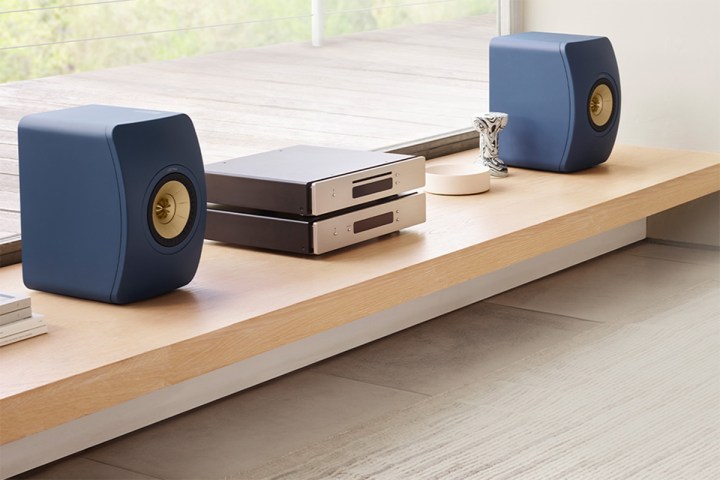
For the audiophile music streamer
KEF LS50 Wireless II
- Clean, bold sound
- Easy to use
- Wi-Fi, USB, and HDMI ARC inputs
- Expensive
- Lacks RCA input for turntables
Known for their gorgeous detail and flat response, the wired iteration of KEF’s LS50 Meta bookshelf speakers have long ranked among the most beloved compact speakers in the audiophile world. But since then, the company introduced an internally amplified wireless iteration in 2017 that now has a successor all its own.
KEF didn't have to go back to any drawing board because this iteration carries over the power, precision, and beauty that made the LS50 Wireless a joy to look at and listen to. At the core of the LS50 Wireless II is a technology called Metamaterial Absorption Technology (MAT), which is a clever way of saying the speakers can absorb unwanted sound in the tweeter's rear so that it doesn't affect the forward output.
Controlled by a smartphone app, they support Wi-Fi streaming from your device’s library, as well as Tidal, Spotify, Amazon Music, and Deezer. The Connect app can access Internet radio stations, and the speakers can play network audio at up to 24-bit/192kHz resolution, including built-in support for both AirPlay 2 and Chromecast. There's even Bluetooth, plus a slew of wired inputs, including HDMI, optical, coaxial, USB-A, and RCA so you could even connect a turntable.
Each speaker contains two built-in amplifiers — one for the woofer, one for the concentric tweeter — that combine for up to 280 watts per channel. That’s more than enough volume to blast music in all but the largest spaces and makes the LS50 II Wireless versatile enough to function well where some may have considered placing floor-standing speakers.
If you’re looking for big sound without the hassle of outboard amplifiers, preamps, and other gear, there is no better option than the KEF LS50 Wireless II, though you can easily fill a room even further through their two subwoofer outputs.
With easier use cases, new colors to choose from, and even better sound quality, the KEF LS50 Wireless II are the kind of 21st-century speakers that you’ll rave about for a long time to come.

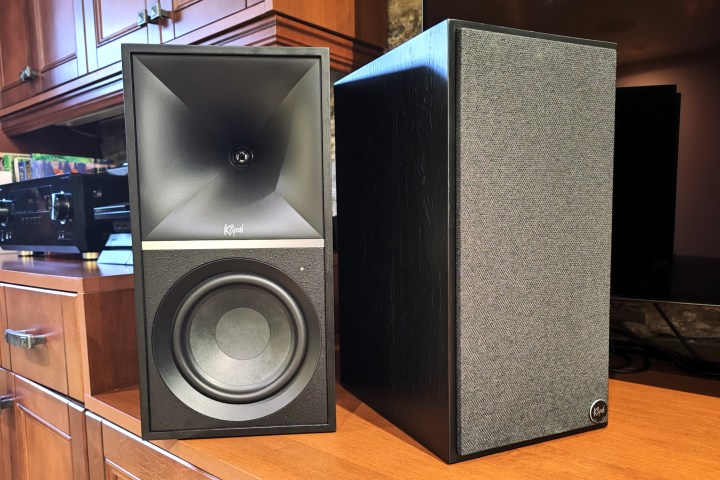
Svelte and classic-looking powered speakers
Klipsch The Sevens
- Incredible sound
- Top-quality design/materials
- Generous inputs
- Adjustable EQ
- No Wi-Fi connection
- Can't see indicators when seated
Klipsch's excellent Heritage Wireless Room Speaker range not only sport a beautiful and classic wood finish that adds retro cool to your setup (they're also available in black, just in case), but the Sevens — the middle child in the range that includes The Fives and the big old The Nines ($1,500) — offer up a beefy 200 watts (400 peak) of volume and beautiful bass response so you don't need to add a sub. They're not overly small, and you might have a tough time setting them up on either side of your TV (should you want to use them as such), so it's a good thing they look so good.
Which brings us to their connectivity options. The beauty of many powered speakers is their versatility, and The Sevens are no different. HDMI-ARC means they'll sound great with your TV, but they also feature a phono preamp for connecting a turntable, digital optical should you want to stream hi-re lossless from a network streamer, RCA and USB inputs, and Bluetooth 5.
One of the unique features of The Sevens (and the rest of the Heritage range) is their top-mounted controls, which look sexy and include a source switch volume dial that's easily accessible — no reaching around the the back or the need to use an app, which The Sevens also have.
Our reviewer, Simon Cohen, loved the sound of The Sevens, praising the clarity of their 6.5-inch woofers and the overall clarity, precision, soundstage, and bass response, which also gets a boost from Klipsch's Dynamic Bass EQ feature. The only downside, Cohen points out, is that they don't do Dolby Atmos, something to keep in mind if you intend to use them as your daily TV driver. As primarily a music system, it's hard to beat The Sevens, but they'll also sound great in your TV room. Plus, if you want even more power, but like what Klipsch is doing here, check out The Nines.

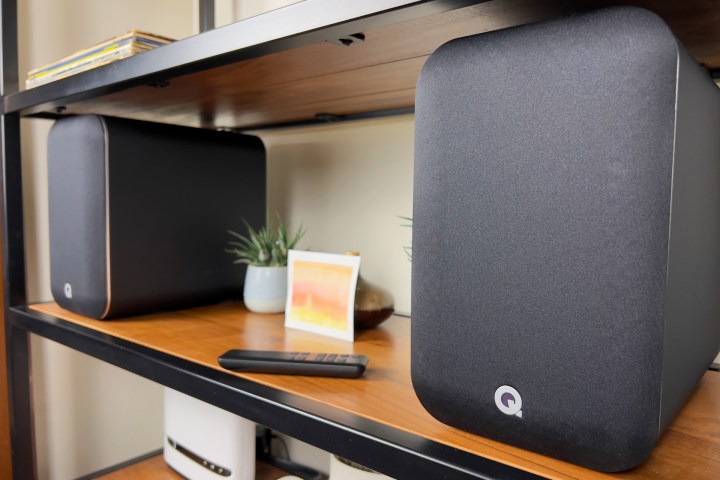
Most versatile Bluetooth speaker system
Q Acoustics M20 HD Powered Wireless Music System
- Clear, refined sound with any music
- Wide soundstage in any room
- Versatility of placement
- Tons of connectivity options
- aptX HD Bluetooth
- A bit big for desktops
- Better with a subwoofer
The way we listen to music and other audio is changing and will continue to change, as consumers explore formats like vinyl records and lossless audio streaming servies, and even integrate their TV and movie watching experiences with their sound systems and setups.
Component audio systems are great, but they can be expensive and complicated. More desktop solutions, like the Q Acoustics M20 Bluetooth speakers, are going well beyond basic Bluetooth speakers to offer a more complete "music system," as we discovered when reviewing them. Sure, they're a great set of desktop speakers, but with a ton of connectivity options, including RCA, optical Toslink, USB, 3.5mm AUX, and aptX HD Bluetooth for high-resolution streaming at 24-bit/48kHz, and some innovative digital processing that lets you tell the speakers where they're being set up (in a corner, against a wall), the M20s are easily one of the most versatile and configurable sets of powered speakers that can serve a variety of sound functions.
Connected to a TV, computer, turntable, DVD player, you name it, the M20s sound big, clear, and dynamic, no matter what you play through them. The only area we found could use a little help was the low end, which could easily be remedied by adding a subwoofer (there's a sub-out port, too). Well worth the $600 price tag.
If you like the look and the features of the M20s but think you might need something bigger and louder, Q Acoustics recently launched the $999 M40 powered tower speakers as well.

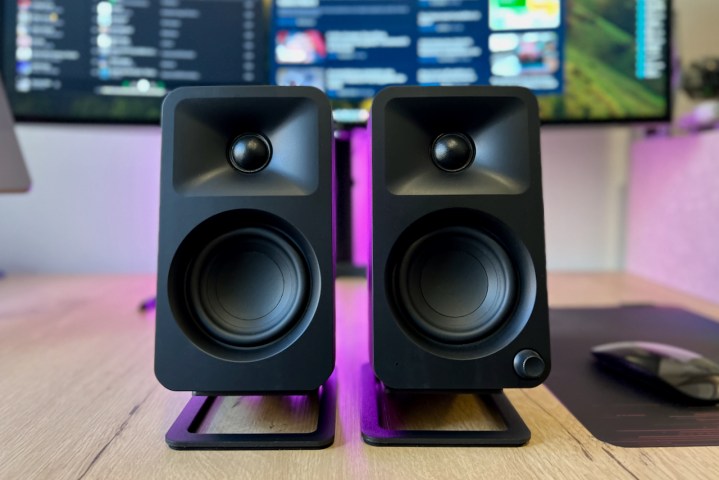
Best desktop computer speakers
Kanto Ora
- Small, discreet footprint
- Impossibly clear reference sound
- Mids and highs that shine
- Killer low-end, especially with a sub
- 100 watts of power
- USB-C and Bluetooth connectivity
- A bit pricey
- No Bluetooth aptX support
- An optical input would be nice
- Doesn't come with cables
There's no rule that says that your office desk or PC gaming setup shouldn't have absolutely killer sound, even if you don't have a lot of space for big speakers. The Kanto Ora Reference Desktop Speakers are perfect for listening to music when you work, especially if that work involves mixing music or editing sound in videos.
As reference speakers, the Kanto Oras offer up precise, accurate sound with a flat frequency response that adds no color to the sound, meaning the music sounds just as it was recorded. And when I reviewed the Oras, they delivered — their sound is crystal clear, with particularly dynamic and beautiful mids and high frequencies that never fatigue the ears. And while the low frequencies of the Oras are full and rich on their own, especially for a set of speakers no larger than a small box set of DVDs, adding a subwoofer through their built-in output elevates the sound of these tiny speakers (each with a ¾-inch silk dome tweeter and a 3-inch woofer) to the truly remarkable.
The Kanto Oras feature all the key inputs needed for a range of connectivity, including RCA line in for a turntable or other analog sources, USB-C for a computer connection capable of up to 16-bit/48kHz playback, and Bluetooth (although, just SBC).
At $350, the Kanto Oras seem a bit pricey, but their 100 peak Class D watts of power (50 watts of bi-amplified power per speaker),and their pristine sound quality make them well worth the price.


Best overall Bluetooth speaker
JBL Xtreme 4
- Warm, rich, and dynamic sound
- Clear at higher volumes
- Insane 30-hour battery life
- Replaceable battery
- IP67 waterproof rating
- Expensive
- No AUX input
Following in the footsteps of the super-popular Xtreme 3, JBL's new and improved model for 2024 is so far the best-sounding mid-sized Bluetooth speaker we've heard all year, landing it at the top of our best Bluetooth speakers list.
Why? Because its classic JBL sound signature sounds excellently balanced, big and smooth on the low end, and articulate and lively in the mids and highs, no matter the kind of music you like — and it can all be tweaked through the JBL Portables app.
For its rugby-ball sized design, the 100 watts of volume the Xtreme 4 pumps out is loud enough to fill whatever room you place it in, wherever you take it. And you will take it with you — its handy shoulder strap (with built-in bottle opener!) and IP67 dust and waterproof rating will make sure of that, removing any trepidation you might have about setting up next to a pool or on a dock.
One of the most significant upgrades the Xtreme 4 has received is in its battery life, with a huge step up form the Xtreme 3's 15 hours to a huge 24 hours (30 if using the Xtreme 4's Playtime Boost feature). But that isn't even the best part. Like several of JBL's newest speakers, the Xtreme 4 has a removable and replaceable battery pack, meaning you can extend the life of the speaker indefinitely.
The only hurdle some may not be able to get over is the Xtreme 4's $380 price, which we think is well worth it for the quality, ruggedness, portability, and longevity the speaker brings to the table.


The best Wi-Fi speakers you can buy
Sonos Era 100
- Big, expansive sound
- Bluetooth now built-in
- Optional analog line-in
- Super-easy room tuning
- No Google Assistant option
Sonos has been around for a minute, and when it comes to Wi-Fi-powered listening, it's one of the best brands in the world. For years, the Sonos Play:1 and One speakers were a Digital Trends favorite, and the only reason the previous generation is being nixed from this roundup (and discontinued from Sonos' lineup, actually) is because Sonos has an all-new lineup of Wi-Fi speakers. And for our money, the Sonos Era 100 is the best networkable speaker for most folks.
It all starts with the engineering and precision that has been such a staple of Sonos speakers for generations. Regardless of its small cylindrical shape, the Era 100 pushes out an impressively large amount of sound, and that's before we get into features like Automatic TruePlay (for iOS only), a returning calibration tool that fine-tunes the Era's projection based on your listening environment.
One of the best additions to Sonos' latest and greatest Wi-Fi speakers is the inclusion of Bluetooth as an alternative means of portable listening. Unlike the Sonos Move or Roam though, you'll need to have the Era 100 connected to a power source at all times. We're also excited to see the return of Alexa-powered voice controls and Sonos' own Voice Controller tool, but the lack of Google Assistant makes us a little sad.
Now for the final slice of bread on the compliment sandwich: The incredible Sonos S2 app is still one of the best companion apps for controlling all your Sonos equipment, as well as streaming music to all your networked speakers. Sonos really didn't have much to fix from one generation of hardware to the next, which makes all the Era's improvements and new features extra cool.
The Sonos Era 100 is a world-class WI-Fi speaker, but honorable mention goes to its bigger and Dolby Atmos-capable sibling, the $450 Sonos Era 300.

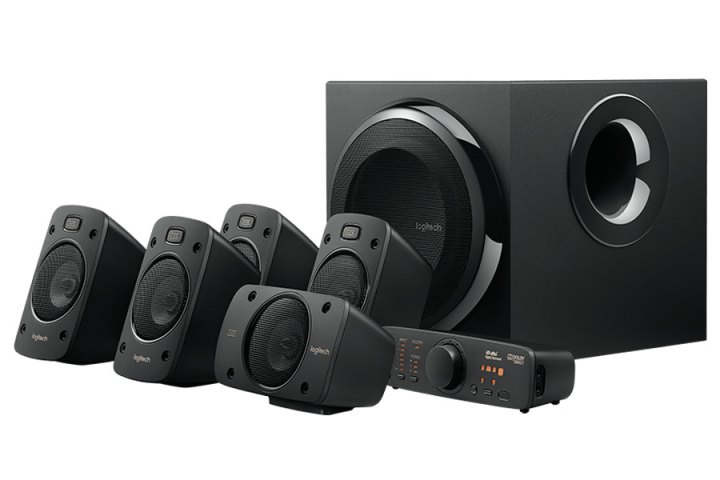
Go-to surround sound for gamers
Logitech Z906
- Powerful, loud sound
- Sturdy, quality design and build
- Great for movies, too
- Lacks HDMI support
Headphones will always be a popular choice for gamers, thanks to the built-in mics that let you talk to your teammates in online multiplayer titles. But there are times when you want to put down the headset and let the sound surround you. Enter the Logitech Z906, a 5.1 speaker system that is all business when it comes to delivering an invigorating surround sound experience.
Have a ton of components? Not to fear. The Z906's media module allows you to line up to six of your favorite devices, ensuring you'll get blistering audio for every gaming system you own — 1,000 total watts of audio, that is. Best of all, this is no regular theater-in-a-box, as the Z906 can also tackle Dolby and DTS decoding for all of your go-to movies, TV shows, and whatever games support the two formats.
While perhaps a bit too bass-heavy for some, the Logitech Z906 system is the ultimate solution for any gamer looking to ditch the headphones in favor of speaker-driven firefights.

Frequently Asked Questions
That's hard to say, as sound can be highly subjective. That being said, brands like Bose, Klipsch, JBL, Bowers and Wilkins, and KEF tend to be recognized as some of the best speaker names in audio. It also depends on what you'll be using your speakers for. The best home theater speakers may not show off a fine collection of jazz vinyl. On the other side of the token, you wouldn't blast superhero films through a record connoisseur's bookshelf set. For a more thorough look, check out our roundup of the best speaker brands of 2024.
It depends on what you're looking for in a speaker. Let's say you're after a great-sounding portable speaker. You'll want to look for a product that can handle the elements, and provide multiple forms of connection (auxiliary, Bluetooth, Wi-Fi, etc.), along with plenty of battery life for the times when you don't have ready access to a charging station. If you're looking for a dedicated set of home theater speakers, you'll want to focus on features like wattage, resistance, driver and cabinet materials, as well as aesthetic craftsmanship. After all, no one wants to own a premium set of hi-fi speakers that have no chance of blending in with home decor.
Wattage doesn't necessarily translate to "quality." Wattage is merely a measure of how much power a speaker is capable of outputting. While a 1,000-watt speaker may be louder than a 100-watt speaker, what tends to matter most is the engineering that goes into the speaker as a whole, accounting for everything from cabinet to drivers, woofers, and tweeter(s).
Not necessarily. Yes, there are high-wattage speakers that pack quite a punch in terms of volume and sound incredible, but most folks will be more than happy with a 50-watt set of high-quality bookshelf speakers that focus more on design and engineering rather than pure power.
There are a number of things you can do to bolster the sound quality of your speakers. For starters, take a look at your listening space. Would moving a couch or chair benefit your experience? What about the speakers themselves? Typically, you'll want to try and triangulate your seating to place you in the center of the listening space, with your speaker drivers aimed towards you. Subwoofers are a whole different story.
If your speakers are placed on the floor, try and place them on shelves or speaker stands. Bookshelf speakers will often sound better when matched to your ear height when seated.
There are also a number of EQ options you can probably play with on your A/V receiver or stereo amplifier. Open these menus up and tweak things like speaker size, decibel output, and sound formats to see if it makes a difference in the final sound.
Everything from size, cabinet/driver design, power handling, and frequency response goes into what makes a top-tier speaker a top-tier. Typically, offerings from dedicated audio companies will be the better choices, but there's a host of incredible speakers produced by TV companies and other electronics umbrellas. Ultimately, the final word comes down to what you think. Wire up, sit back, and soak in the sound.
Yes, many powered speakers support Wi-Fi and Bluetooth. Just make sure that you check the specs and consider device compatibility before you purchase.
Yes, absolutely. Google Assistant and Alexa are supported by a growing collection of smart speakers, portable speakers, soundbars, and receivers.
That depends. If you are in a small space, we don’t recommend it, but if you’re looking to make a small pair of speakers perform better with hip-hop, dance music, or for more cinematic sound, we recommend considering a good subwoofer to reach the lowest end of the frequency spectrum. Most pairs of speakers do not come with a subwoofer unless indicated, but most soundbars do.
Unless your speakers are powered, you will need some form of stereo or integrated amplifier or AV receiver to power them.
Some powered speakers do have USB inputs to support digital music — just make sure to check the spec list if this is desired.
Most powered speakers do offer a 3.5mm input. Most amplifiers and receivers offer an RCA input, but you can use an adapter to easily connect a 3.5mm source.
Technically yes, but you’ll want to make sure that the impedance matches, and you might want to consider a larger, more powerful amplifier for larger speakers. As a general rule, it is usually better to have too much power than not enough (although you’ll want to be careful to make sure you don’t damage your speakers).
We test speakers the way normal people live.
We run every speaker through a rigorous process over the course of several days or weeks. That includes playing them in all sorts of scenarios, be it in the listening room, computer room, or at the office, and playing back from our device library, CDs, vinyl, and streaming services like Spotify.
For wireless speakers, we also test range, connection stability, and interference in areas with a lot of radio frequency interference. For non-powered speaker models, we listen via a variety of amplifiers, ensuring we have a good idea of what each model is doing given different power and sources.
Finally, we compare each speaker to some of our go-to models, both in their class and price point, as well as a level or two above to find out if they can punch above their weight. This ensures that we are putting them in perspective with the larger industry, and also cements the way that we think about the price-to-performance ratio of each speaker we test.





